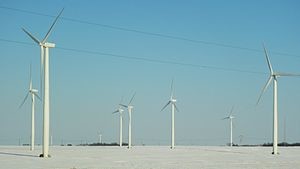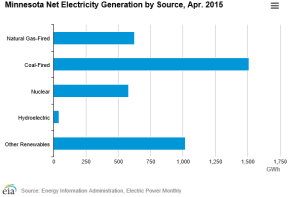
According to the U.S. Energy Administration, Minnesota has met that goal, getting 28% of it’s electricity from renewables, 40% from coal, 17% from natural gas, and 15% from nuclear. Minnesota Power announced in June that it was closing two of its coal-powered plants on Lake Superior. Governor Mark Dayton has called for completely eliminating coal from energy production in Minnesota.A Public Policy Polling poll released last week showed a majority of Minnesotans are in favor of President Obama’s new carbon emissions mandate from the U.S. Environmental Protection Agency. 57% of Minnesotans polled said they believe climate change is a “serious problem” and 60% said they supported the EPA’s new “Clean Power Plan.” The EPA released state-by-state targets on August 2nd that will require Minnesota to cut carbon emissions by 40.3% by 2030 in the name of affecting climate change. Per the Star Tribune, Senator Al Franken and Xcel Energy CEO Ben Fowke attended the announcement at the White House.
In 2007 Minnesota passed– what were at the time– the most stringent energy mandates outside of California which required that large utilities attain 25% of their energy output from renewable sources by 2025. The legislature followed up with a solar mandate in 2013 requiring large Xcel Energy, Minnesota Power, Ottertail Power, and Interstate Power & Light to get 1.5% of their power from the sun by 2020.
According to the U.S. Energy Administration, Minnesota has met that goal, getting 28% of it’s electricity from renewables, 40% from coal, 17% from natural gas, and 15% from nuclear. Minnesota Power announced in June that it was closing two of its coal-powered plants on Lake Superior. Governor Mark Dayton has called for completely eliminating coal from energy production in Minnesota.
Xcel Energy serves 1.2 million customers in Minnesota and has continually been requesting rate hikes over the past decade. The company was granted a permanent 3.8% rate hike in 2013, although they requested 7.8% . They asked for a 10.4% rate increase over two years in 2014 with most of the money being used on existing power plants and to keep their two nuclear facilities running for the next twenty years. 25% of the increase was to be used to offset the capital cost to acquire wind farms. State regulators instead approved a 4.6% increase for 2014 and a 1.5% increase for 2015. According to MPR News, the state denied Xcel’s request to use money for an upgrade to the Monticello nuclear plant.
As energy companies’ prices are tamped down by state regulators, and the federal government demands they get more of their power from renewable sources, some states will head to court to fight the mandates. Seventeen states so far have joined a federal lawsuit against the EPA with more expected to sign on soon.
Minnesota’s two largest providers, Xcel Energy and Minnesota Power, will be required to submit plans to the state by this fall demonstrating how they’ll meet the Obama administration’s new mandate.






